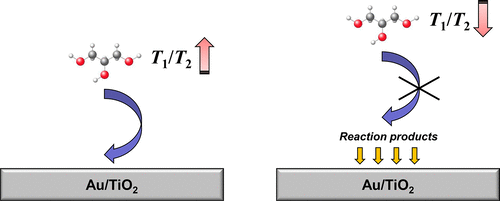当前位置:
X-MOL 学术
›
ACS Catal.
›
论文详情
Our official English website, www.x-mol.net, welcomes your
feedback! (Note: you will need to create a separate account there.)
Product Inhibition in Glycerol Oxidation over Au/TiO2 Catalysts Quantified by NMR Relaxation
ACS Catalysis ( IF 11.3 ) Pub Date : 2018-06-20 00:00:00 , DOI: 10.1021/acscatal.8b01516 Carmine D’Agostino 1 , Robert D. Armstrong 2 , Graham J. Hutchings 2 , Lynn F. Gladden 3
ACS Catalysis ( IF 11.3 ) Pub Date : 2018-06-20 00:00:00 , DOI: 10.1021/acscatal.8b01516 Carmine D’Agostino 1 , Robert D. Armstrong 2 , Graham J. Hutchings 2 , Lynn F. Gladden 3
Affiliation

|
Liquid-phase catalytic oxidation of glycerol in aqueous solutions using porous solid catalysts represents a viable strategy for the sustainable production of fine chemicals from renewable resources. Various aspects of these novel types of reactions are still under investigation. Catalyst deactivation is one of those issues that need to be understood and addressed in order to make these processes commercially viable. In a previous study, it has been reported that the catalytic activity of Au/TiO2 catalysts for the oxidation of glycerol with O2 under basic conditions can be severely inhibited by some reaction intermediates or products. It was suggested that the presence of certain species blocks the active sites of the catalyst, preventing the adsorption of glycerol, which in turn results in a decrease of reaction rate. In this work, we used NMR relaxation time measurements in order to assess surface interactions of glycerol in a Au/TiO2 catalyst pretreated with aqueous solutions of various oxygenates, including intermediates and products of glycerol oxidation, under basic conditions, in particular, evaluating changes in glycerol adsorption properties. The NMR T1/T2 ratio of glycerol, which is indicative of the strength of interaction of glycerol with the catalyst surface, traces out well the trend in catalytic activity in the presence of different additives, suggesting that adsorption of glycerol onto the catalyst surface plays a crucial role in the reaction, which supports the hypothesis previously made in the literature. This experimental approach and the related results represent a significant advance in the understanding of liquid-phase catalytic reactions occurring over solid surfaces, which can be used to understand and optimize catalytic processes and the effect of intermediate and product inhibition.
中文翻译:

NMR弛豫定量分析Au / TiO 2催化剂对甘油氧化产物的抑制作用
使用多孔固体催化剂的水溶液中甘油的液相催化氧化是从可再生资源可持续生产精细化学品的可行策略。这些新型反应的各个方面仍在研究中。为了使这些方法在商业上可行,催化剂失活是需要理解和解决的那些问题之一。在先前的研究中,已经报道了Au / TiO 2催化剂对甘油被O 2氧化的催化活性。在碱性条件下可被某些反应中间体或产物严重抑制。有人提出,某些种类的存在会阻止催化剂的活性位点,阻止甘油的吸附,进而导致反应速率降低。在这项工作中,我们使用NMR弛豫时间测量来评估在碱性条件下用各种含氧化合物水溶液(包括甘油氧化的中间体和产物)预处理的Au / TiO 2催化剂中甘油的表面相互作用,尤其是评估变化在甘油中的吸附特性。NMR T 1 / T 2甘油的比率表明甘油与催化剂表面的相互作用强度,很好地描绘了在存在不同添加剂的情况下催化活性的趋势,这表明甘油在催化剂表面上的吸附在反应中起着至关重要的作用。 ,它支持先前文献中提出的假设。该实验方法和相关结果代表了对在固体表面上发生的液相催化反应的理解的重大进步,可用于理解和优化催化过程以及中间产物和产物抑制作用。
更新日期:2018-06-20
中文翻译:

NMR弛豫定量分析Au / TiO 2催化剂对甘油氧化产物的抑制作用
使用多孔固体催化剂的水溶液中甘油的液相催化氧化是从可再生资源可持续生产精细化学品的可行策略。这些新型反应的各个方面仍在研究中。为了使这些方法在商业上可行,催化剂失活是需要理解和解决的那些问题之一。在先前的研究中,已经报道了Au / TiO 2催化剂对甘油被O 2氧化的催化活性。在碱性条件下可被某些反应中间体或产物严重抑制。有人提出,某些种类的存在会阻止催化剂的活性位点,阻止甘油的吸附,进而导致反应速率降低。在这项工作中,我们使用NMR弛豫时间测量来评估在碱性条件下用各种含氧化合物水溶液(包括甘油氧化的中间体和产物)预处理的Au / TiO 2催化剂中甘油的表面相互作用,尤其是评估变化在甘油中的吸附特性。NMR T 1 / T 2甘油的比率表明甘油与催化剂表面的相互作用强度,很好地描绘了在存在不同添加剂的情况下催化活性的趋势,这表明甘油在催化剂表面上的吸附在反应中起着至关重要的作用。 ,它支持先前文献中提出的假设。该实验方法和相关结果代表了对在固体表面上发生的液相催化反应的理解的重大进步,可用于理解和优化催化过程以及中间产物和产物抑制作用。











































 京公网安备 11010802027423号
京公网安备 11010802027423号